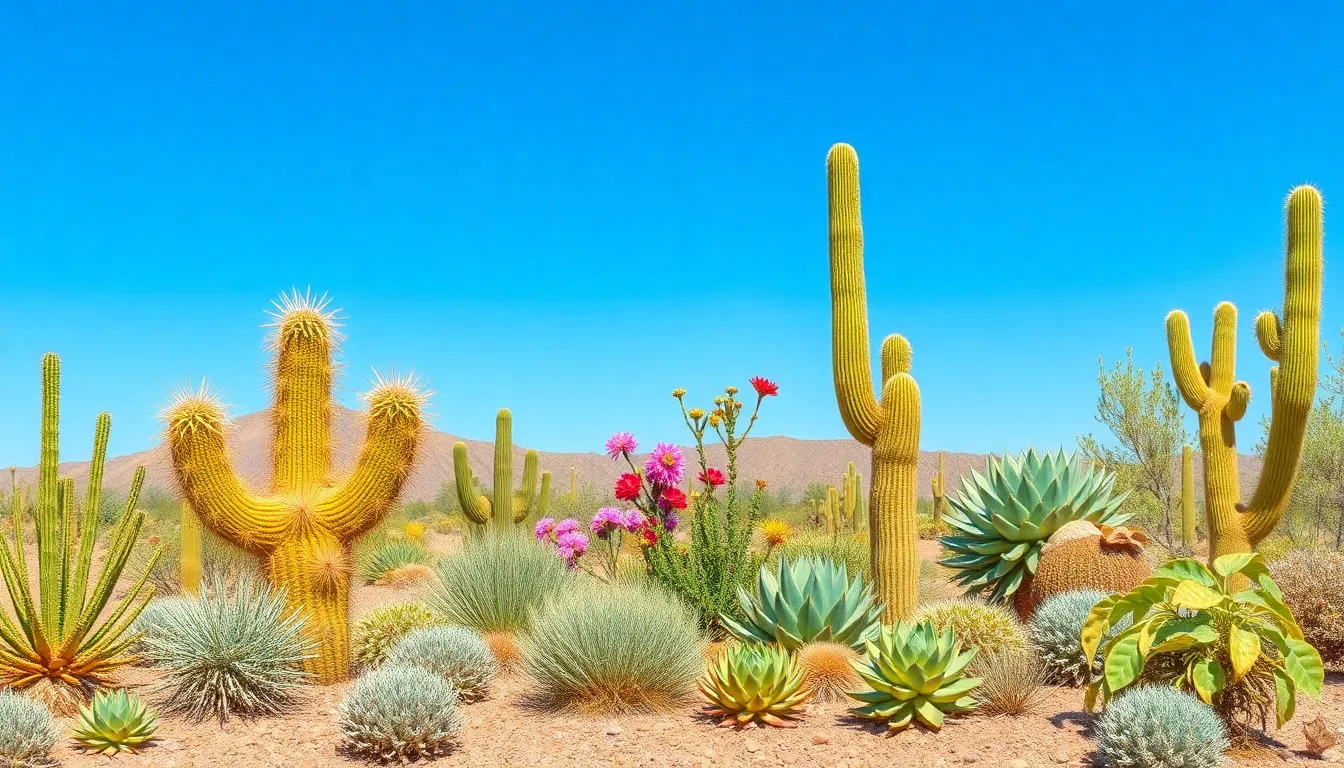Deserts might seem like barren wastelands, but they’re actually home to some of the toughest little green warriors on the planet. These plants have mastered the art of survival in extreme conditions, proving that even in the harshest environments, life finds a way. From sassy succulents to resilient cacti, desert flora showcases nature’s ingenuity and adaptability.
Plants That Grow In The Desert
Desert plants exhibit remarkable adaptations to survive in arid conditions. They often possess specialized structures for water retention. For instance, cacti have thick fleshy stems that store moisture. Succulents display similar traits, storing water in their leaves.
Some desert plants have deep root systems that tap into underground water sources. Others utilize shallow roots to quickly absorb moisture from rainfall. Drought-resistant leaves minimize water loss through evaporation. Examples include the waxy coating on desert aloe leaves.
Many desert plants employ photosynthesis adaptations to handle extreme sun exposure. Cacti can engage in a process called CAM, where they absorb CO2 at night and store it for use during the day. This method significantly reduces water loss during hot days.
White sand or light-colored stones often surround desert plants, helping to reflect sunlight. This natural insulation protects these plants from overheating. Various species exhibit unique flowering patterns, often blooming after rare rainfalls to take advantage of moisture.
Some plants develop thorns or spines to deter herbivores. Other species demonstrate a symbiotic relationship with local animals, relying on them for pollination or seed dispersal. Overall, desert plants reveal the extraordinary capacity of life to evolve and adapt, thriving in one of the planet’s harshest environments.
Types Of Plants That Grow In The Desert

Desert ecosystems host a variety of plant species, each uniquely adapted to thrive in arid conditions. Common categories include cacti, succulents, and drought-resistant shrubs.
Cacti
Cacti represent remarkable survival strategies in desert environments. These plants often feature thick, fleshy stems that store water efficiently. Spines replace traditional leaves, reducing water loss through evaporation. Many cacti, such as the iconic saguaro, develop extensive root systems that capture rainfall quickly. Cacti also utilize CAM (Crassulacean Acid Metabolism) photosynthesis to maximize carbon dioxide absorption at night. High adaptability allows them to endure extreme heat and drought by minimizing moisture loss.
Succulents
Succulents encompass a diverse group of plants with thickened leaves or stems designed for water storage. These adaptations enable them to survive infrequent rainfall in their habitats. Popular examples include aloe vera and agave, each exhibiting unique leaf structures that prevent water loss. Shallow roots allow quick absorption of moisture during rare rain events, while their fleshy tissues store water for periods of drought. Colorful blooms attract pollinators, contributing to their reproduction in challenging conditions.
Drought-Resistant Shrubs
Drought-resistant shrubs play a vital role in desert ecosystems. Species like creosote bush exhibit deep-root systems, accessing groundwater unavailable to many other plants. Their waxy leaf coatings minimize transpiration, allowing them to conserve water effectively. These shrubs also thrive in sandy soils, further aiding their ability to survive extreme conditions. Some produce flowers after infrequent rains, providing essential resources for pollinators and supporting local biodiversity. Resilience defines these plants, showcasing their ability to flourish amidst harsh environments.
Adaptations Of Desert Plants
Desert plants exhibit remarkable adaptations for survival in arid environments. These strategies enhance their resilience and efficiency amidst harsh conditions.
Water Conservation Strategies
Many desert plants utilize unique water conservation techniques. Cacti feature thick, fleshy stems that store significant amounts of water. They also possess a waxy coating on their surfaces, reducing evaporation. Succulents like aloe vera store moisture within their leaves, which further aids in drought management. While some plants develop deep roots to tap into underground reservoirs, others maintain shallow roots for rapid water absorption during brief rain events. Drought-resistant leaves serve as additional adaptations, minimizing water loss while maximizing hydration.
Soil Adaptations
Soil adaptations play a critical role in the survival of desert plants. Many species thrive in sandy or rocky substrates, which facilitate drainage and prevent root rot. Plant roots often spread wide instead of deep to access moisture efficiently. Some desert plants employ mycorrhizal fungi to enhance nutrient uptake, establishing symbiotic relationships with soil microbes. This cooperation allows plants to thrive despite nutrient limitations. Additionally, certain species produce allelochemicals that modify soil chemistry, reducing competition for nutrients. These strategies collectively enable desert plants to flourish despite harsh soil conditions.
Importance Of Desert Plants
Desert plants play a crucial role in maintaining the ecological balance of their environments. These species support biodiversity by providing food and habitat for various wildlife. Cacti, for example, offer shelter for birds and small mammals while supplying nectar for pollinators.
Water conservation stands as a primary function of desert plants. They have evolved remarkable adaptations, which allow them to retain moisture and survive prolonged dry spells. The thick, fleshy stems of cacti, along with the water-storing leaves of succulents, illustrate this essential survival strategy.
Soil health benefits from the presence of desert plants. Many species enhance soil structure and prevent erosion through their extensive root systems. These roots also facilitate the absorption of vital nutrients, boosting the overall fertility of the ecosystem.
Photosynthesis adaptations contribute to the importance of desert plants. Techniques like CAM allow cacti to efficiently convert carbon dioxide into energy during cooler nighttime temperatures. This approach reduces water loss typically associated with photosynthesis, showcasing their efficiency in arid conditions.
Cultural significance also exists with desert plants. Indigenous communities have historically relied on these plants for food, medicine, and materials. Their knowledge of local flora underscores the connection between people and their environment.
The resilience of desert plants showcases nature’s ingenuity. These organisms endure extreme temperatures and scarce rainfall, thriving where many others cannot. The ability to adapt and flourish emphasizes their role in desert ecosystems, supporting the idea that life persists even in the harshest conditions.
Conclusion
Desert plants stand as a testament to nature’s resilience and adaptability. Their unique adaptations allow them to thrive in some of the world’s most challenging environments. By conserving water and utilizing specialized structures for survival, these plants not only endure but also contribute significantly to their ecosystems.
Their role in supporting biodiversity and maintaining ecological balance is vital. As they provide food and habitat for various wildlife, they also play a crucial part in the cultural practices of indigenous communities. Understanding and appreciating these remarkable plants fosters a deeper connection to the environment and highlights the importance of preserving these unique ecosystems for future generations.

